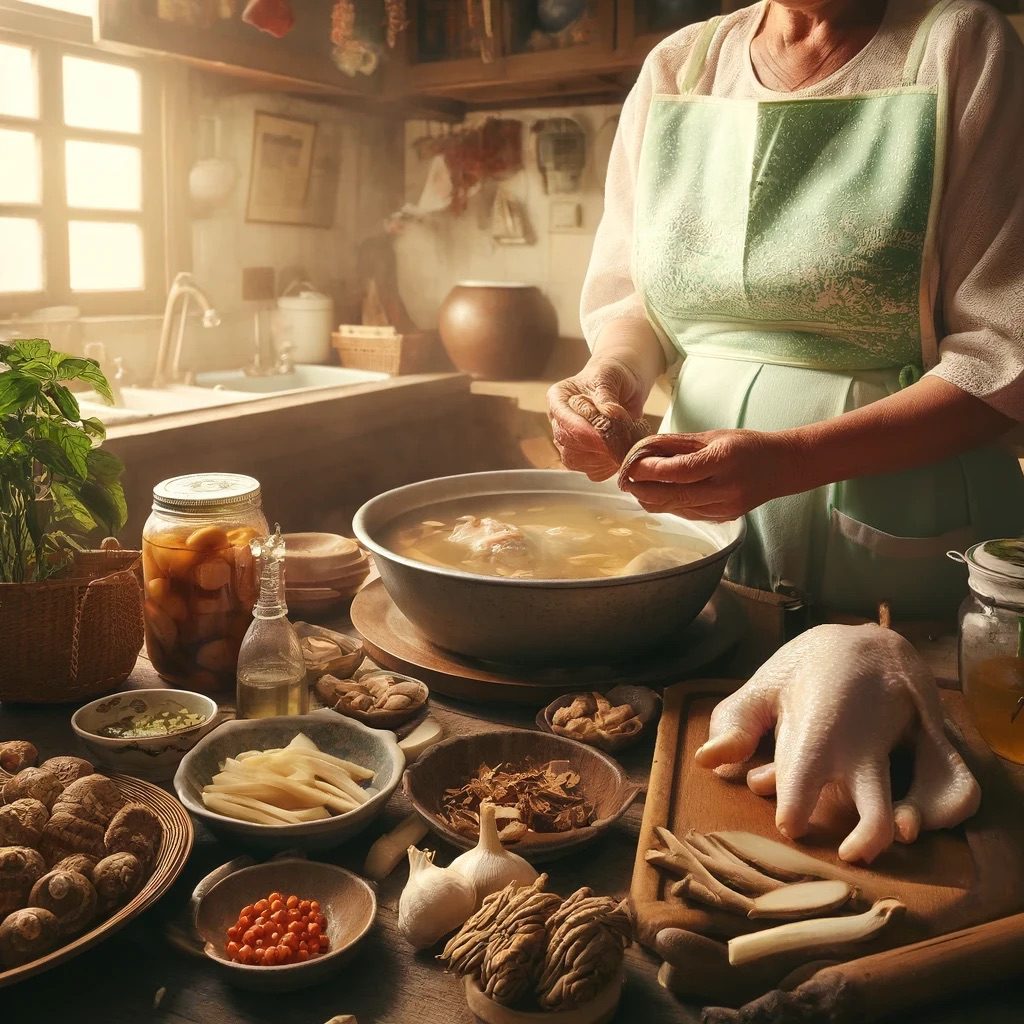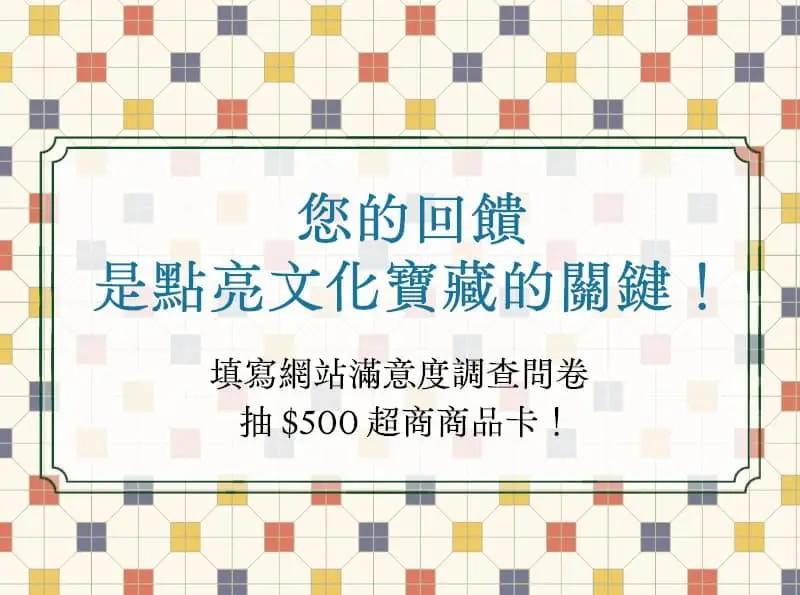我媽媽的廚藝不太好,也沒有時間花心思在廚房裡,所以不會做複雜料理。即使她很早就吃素了,她仍然煮著雞湯給我們。
我們家就住在傳統市場附近,所以她能買到新鮮的食材,而現在的我不敢在傳統市場買雞肉,超市買的雞肉常是進口,並且是冷凍過後解凍,煮出來的味道和媽媽的不一樣。
在老師的引導中,我走到常去的超市,聞著超市的冷氣味,在寒冷的冷藏櫃中拿起封裝雞肉,白色的雞皮看起來沒有血色,沒有肉味的氣息。
帶著食材回家,先用薑片和米酒將雞肉稍微川燙,再將已經泡水的乾香菇一起放到鍋子裡,加點蒜頭提味,將電鍋裡放入一杯水,希望能煮出一鍋好吃的香菇雞湯。
煮好的雞湯裡也可以加入高麗菜,或是搭配麵線,就能讓身體溫暖起來,心裡也會覺得暖暖的。臺北的冬天常常濕濕冷冷,有了雞湯,可以讓人恢復元氣。
不論是多麼簡單的料理,都需要採買、前置作業,其實並不輕鬆。但是自己煮的總是真材實料,沒有人工添加物。
現在的我也已經結婚,很幸運的,我的婆婆總是為家人下廚,愛烏及烏之下,我也能感受到料理中的愛心。婆婆也常做各種雞湯,香菇雞湯也是其中之一。雖然婆婆煮的香菇雞湯和我媽媽的味道不太一樣,但一樣的是那一點一滴中對家人的關懷。
When I was a child, my mother often cooked shiitake mushroom chicken soup, probably to ensure we got enough nutrition. The soup was always very fragrant, with a layer of oil floating on top.
My mom wasn't a great cook and didn't have time to spend on complicated recipes. Even though she became a vegetarian early on, she continued to make chicken soup for us.
We lived near a traditional market, so she could buy fresh ingredients. Nowadays, I'm hesitant to buy chicken from the traditional market, and the chicken sold who live in supermarkets is often imported, frozen, and then thawed, which tastes different from my mom's cooking.
Under the teacher's guidance, I imagined walking to my usual supermarket, smelling the cold air, and picking up packaged chicken from the refrigerated section. The pale chicken skin looked bloodless and lacked the fresh scent of meat.
At home, I blanched the chicken briefly with ginger slices and rice wine. Then I added the soaked dried shiitake mushrooms to the pot, along with some garlic for flavor. I put one cup of water in the electric cooker, hoping to make a delicious pot of shiitake mushroom chicken soup.
The cooked chicken soup can also be enhanced with cabbage or paired with noodles to warm the body and heart. Taipei winters are often damp and cold, and a bowl of chicken soup can rejuvenate the spirit.
No matter how simple the dish, it requires shopping and preparation, which isn't easy. But cooking for yourself ensures real ingredients without artificial additives.
Now that I'm married, I'm lucky that my mother-in-law always cooks for the family. Through her kindness, I can feel the love in her cooking. She also makes various chicken soups, including shiitake mushroom chicken soup. Although her version tastes different from my mom's, what remains the same is the care and concern for the family in every bit of it.
-
《島嶼未來料理教室》Future Formosa Culinary Lab Profile Nr.056
22-30歲的宜蘭縣不吃牛,少吃炸物與甜食,喜歡嘗試不同口味,踩雷也不怕者,平均花費100元在餐費上。因為她媽媽吃素,回老家時會去一家素食餐館,比較偏西式的料理方式。如果世界末日終將來到,會選擇與她的先生,希望他安心一起度過最後一刻;關於家庭的一道料理,她提到香菇雞湯
"Avoids beef, fried foods, and sweets; enjoys trying new flavors, unafraid of disappointments."
Female(22-30 yrs)/ Yilan County / 100 NTD per meal
Profound dining impressions were shaped by visiting a vegetarian restaurant with a Western cooking style when she went home.
If the end of the world were to come, she would choose to share the meal with her husband, hoping to spend the last moments together in peace.
As for a family dish, she mentioned mushroom chicken soup.
-
國立臺灣歷史博物館的第 1 個「公共飲食記憶 NFT 化」實驗計畫《超時空島嶼餐桌》
National Museum of Taiwan History's First NFT Experimental Project on Public Dining Memories《Time-Space Dining Tables》
「國立臺灣歷史博物館」為推動國家文化記憶庫之永續發展,融入當代議題、常民生活及在地關懷,連結博物館專業、數位創新思維與多元社群行動,以促進臺灣原生文化之活化運用,鼓勵全民共同開展記憶庫多元主題與主題素材近用。
本計畫案於112年推出《島嶼庫客 Islands Cooker》飲食記憶系列7支影片,探究臺灣飲食的歷史成因,113年延續「餐桌」的概念,加入「未來」元素,委由畸零地創造股份有限公司辦理《島嶼未來料理教室——NFT設計工作坊》,以記憶庫長期深耕之飲食記憶主題,透過非同質化代幣(Non-Fungible Token,以下簡稱 NFT)設計工作坊,增進記憶庫之內容與應用,落實臺灣原生文化之推廣。
《島嶼未來料理教室——NFT設計工作坊》以「推測設計」為核心,反思記憶料理的獨特性,其之於 NFT的當代意義及其飲食文化價值,並將工作坊延伸設計為「發掘身體飲食記憶,運用想像和推測來創造未來島嶼飲食文化」的參與式體驗活動。工作坊由編舞家與引導師,透過一連串的帶領、想像和對話,挖掘及連結蘊藏身體感知中的飲食記憶,並讓參與者書寫飲食記憶;接著由畸零地工作室與生成式AI 「ChatGPT 4o」協作製作出 「記憶食譜 NFT」及文字翻譯;最後線上場以「圍爐」的概念,讓參與者在雲端上互相分享與交流。
這些飲食記憶透過NFT不可替代、數位交換的特性,被永久保存並流傳,期望每個人都能回首屬於自己的飲食記憶和歷史,經由公共化的途徑與媒介,成為社會記憶的一部份,構築社群認同的可能。
To promote the sustainable development of the Taiwan Cultural Memory Bank, the National Museum of Taiwan History integrates contemporary issues, ordinary life, and local concerns. By combining museum expertise, digital innovation, and diverse community actions, it aims to revitalize and utilize Taiwan's indigenous culture. The museum encourages the public to collaboratively develop and access various themes and materials within the memory bank.
This project launched the "Islands Cooker" series of seven videos on culinary memories in 2023, exploring the historical origins of Taiwanese cuisine. Continuing with the concept of the "dining table" and incorporating "future" elements in 2024, the project entrusted Ground Zero Co., Ltd. to handle the "Islands Future Cuisine Classroom—NFT Design Workshop." By delving into the long-term themes of culinary memories from the Taiwan Cultural Memory Bank and utilizing the Non-Fungible Token (NFT) design workshop, the project aims to enhance the content and application of the memory bank, promoting the dissemination of Taiwan's indigenous culture.
The "Islands Future Cuisine Classroom—NFT Design Workshop" centers on "speculative design," reflecting on the uniqueness of memory cuisine and its contemporary significance and culinary cultural value in relation to NFTs. The workshop is extended into a participatory experiential activity, designed as "discovering culinary memories in body and using imagination and speculation to create future island culinary culture." The workshop, led by choreographers and facilitators, guides participants through a series of activities, including imagination and dialogue, to uncover and connect with culinary memories embedded in their bodily perceptions. Participants then write down their culinary memories. Next, Ground Zero Co., Ltd. collaborates with the generative AI "ChatGPT 4o" to create "Memory Recipe NFTs" and translate the texts. Finally, the online session, based on the concept of "reunion dinner," allows participants to share and exchange their experiences and creations in the cloud.
These culinary memories, preserved and circulated through the non-fungible and digital exchange characteristics of NFTs, are expected to be permanently stored and shared. The goal is for everyone to reflect on their own culinary memories and histories, making them part of societal memory through public pathways and media, thereby fostering a sense of community identity.
※本圖像為AI生成內容
※This image is AI-generated content.











